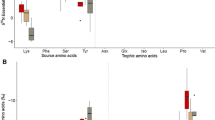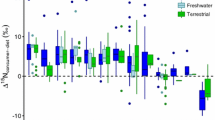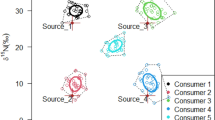Abstract
Stable isotope analysis has become an important tool in studies of trophic food webs and animal feeding patterns. When animals undergo rapid dietary shifts due to migration, metamorphosis, or other reasons, the isotopic composition of their tissues begins changing to reflect that of their diet. This can occur both as a result of growth and metabolic turnover of existing tissue. Tissues vary in their rate of isotopic change, with high turnover tissues such as liver changing rapidly, while relatively low turnover tissues such as bone change more slowly. A model is outlined that uses the varying isotopic changes in multiple tissues as a chemical clock to estimate the time elapsed since a diet shift, and the magnitude of the isotopic shift in the tissues at the new equilibrium. This model was tested using published results from controlled feeding experiments on a bird and a mammal. For the model to be effective, the tissues utilized must be sufficiently different in their turnover rates. The model did a reasonable job of estimating elapsed time and equilibrial isotopic changes, except when the time since the diet shift was less than a small fraction of the half-life of the slowest turnover tissue or greater than 5–10 half-lives of the slowest turnover tissue. Sensitivity analyses independently corroborated that model estimates became unstable at extremely short and long sample times due to the effect of random measurement error. Subject to some limitations, the model may be useful for studying the movement and behavior of animals changing isotopic environments, such as anadromous fish, migratory birds, animals undergoing metamorphosis, or animals changing diets because of shifts in food abundance or competitive interactions.




Similar content being viewed by others
References
Ayliffe LK et al. (2004) Turnover of carbon isotopes in tail hair and breath CO2 of horses fed an isotopically varied diet. Oecologia 139:11–22
Battley PF, Piersma T, Dietz MW, Tang S, Dekinga A, Hulsman K (2000) Empirical evidence for differential organ reductions during trans-oceanic bird flight. Proc R Soc Lond Ser B Biol Sci 267:191–195
Ben-David M, Hanley TA, Klein DR, Schell DM (1997) Seasonal changes in diets of coastal and riverine mink: the role of spawning Pacific salmon. Can J Zool 75:803–811
Ben-David M, Titus K, Beier LR (2004) Consumption of salmon by Alaskan brown bears: a trade-off between nutritional requirements and the risk of infanticide? Oecologia 138:465–474
Bosley KL, Witting DA, Chambers RC, Wainwright SC (2002) Estimating turnover rates of carbon and nitrogen in recently metamorphosed winter flounder Pseudopleuronectes americanus with stable isotopes. Mar Ecol Prog Ser 236:233–240
DeNiro MJ, Epstein S (1978) Influence of diet on the distribution of carbon isotopes in animals. Geochim Cosmochim Acta 42:495–506
DeNiro MJ, Epstein S (1981) Influence of diet on the distribution of nitrogen isotopes in animals. Geochim Cosmochim Acta 45:341–351
Fry B, Arnold C (1982) Rapid 13C/12C turnover during growth of brown shrimp (Penaeus aztecus). Oecologia 54:200–204
Groot C, Margolis L (eds) (1991) Pacific Salmon life histories. UBC Press, Vancouver, BC
Herzka SZ, Holt SA, Holt J (2001) Documenting the settlement history of individual fish larvae using stable isotope ratios: model development and validation. J Exp Mar Biol Ecol 265:49–74
Hesslein RH, Hallard KA, Ramlal P (1993) Replacement of sulfur, carbon, and nitrogen in tissue of growing broad whitefish (Coregonus nasus) in response to a change in diet traced by δ34S, δ13C, and δ15N. Can J Fish Aquat Sci 50:2071–2076
Hilderbrand GV, Farley SD, Robbins CT, Hanley TA, Titus K, Servheen C (1996) Use of stable isotopes to determine diets of living and extinct bears. Can J Zool 74:2080–2088
Hobson KA (1999) Tracing origins and migration of wildlife using stable isotopes: a review. Oecologia 120:314–326
Hobson KA, Clark RG (1992) Assessing avian diets using stable isotopes I: turnover of 13C in tissues. Condor 94:181–188
Hobson KA, Clark RG (1993) Turnover of 13C in cellular and plasma fractions of blood: implications for nondestructive sampling in avian dietary studies. Auk 110:638–641
MacAvoy SE, Macko SA, Garman GC (2001) Isotopic turnover in aquatic predators: quantifying the exploitation of migratory prey. Can J Fish Aquat Sci 58:923–932
MacAvoy SE, Macko SA, Arneson LS (2005) Growth versus metabolic tissue replacement in mouse tissues determined by stable carbon and nitrogen isotope analysis. Can J Zool 83:631–641
Morrison RIG, Hobson KA (2004) Use of body stores in shorebirds after arrival on high-Arctic breeding grounds. Auk 121:333–344
O’Brien DM, Boggs CL, Fogel ML (2004) Making eggs from nectar: the role of life history and dietary carbon turnover in butterfly reproductive resource allocation. Oikos 105:279–291
Pearson SF, Levey DJ, Greenberg CH, Martinez del Rio C (2003) Effects of elemental composition on the incorporation of dietary nitrogen and carbon signatures in an omnivorous songbird. Oecologia 135:516–523
Phillips DL (1989) Propagation of error and bias in half-life estimates based on two measurements. Arch Environ Contam Toxicol 18:508–514
Phillips DL, Gregg JW (2001) Uncertainty in source partitioning using stable isotopes. Oecologia 127:171–179
Phillips DL, Koch PL (2002) Incorporating concentration dependence in stable isotope mixing models. Oecologia 130:114–125
Podlesak DW, McWilliams SR, Hatch KA (2005) Stable isotopes in breath, blood, feces, and feathers can indicate intra-individual changes in the diet of migratory songbirds. Oecologia 142:501–510
Post DM (2002) Using stable isotopes to estimate trophic position: models, methods, and assumptions. Ecology 83:703–718
Tieszen LL, Boutton TW, Tesdahl KG, Slade NA (1983) Fractionation and turnover of stable carbon isotopes in animal tissues: implications for δ13C analysis of diet. Oecologia 57:32–37
Acknowledgements
The information in this document has been funded by the U.S. Environmental Protection Agency. It has been subjected to the Agency’s peer and administrative review, and approved for publication as an EPA document. Mention of trade names or commercial products does not constitute endorsement or recommendation for use. We thank Keith Bosley, Claudio Gratton, Diane O’Brien, Bob Ozretich, David Post, and two anonymous reviewers for constructive reviews.
Author information
Authors and Affiliations
Corresponding author
Additional information
Communicated by David Post
Rights and permissions
About this article
Cite this article
Phillips, D.L., Eldridge, P.M. Estimating the timing of diet shifts using stable isotopes. Oecologia 147, 195–203 (2006). https://doi.org/10.1007/s00442-005-0292-0
Received:
Accepted:
Published:
Issue Date:
DOI: https://doi.org/10.1007/s00442-005-0292-0




